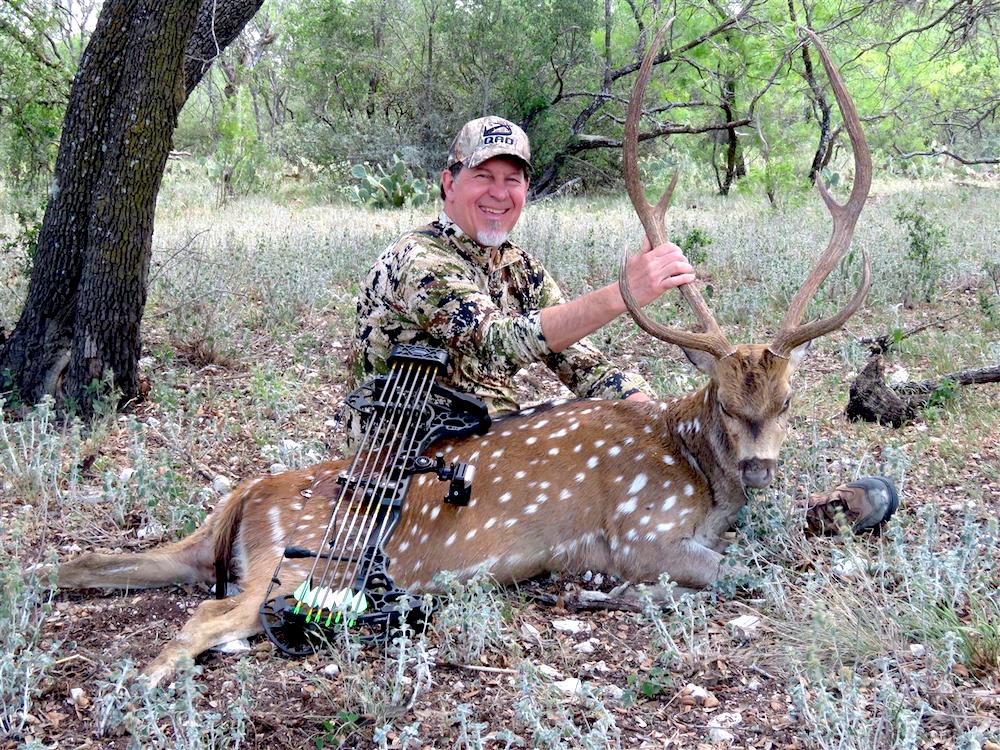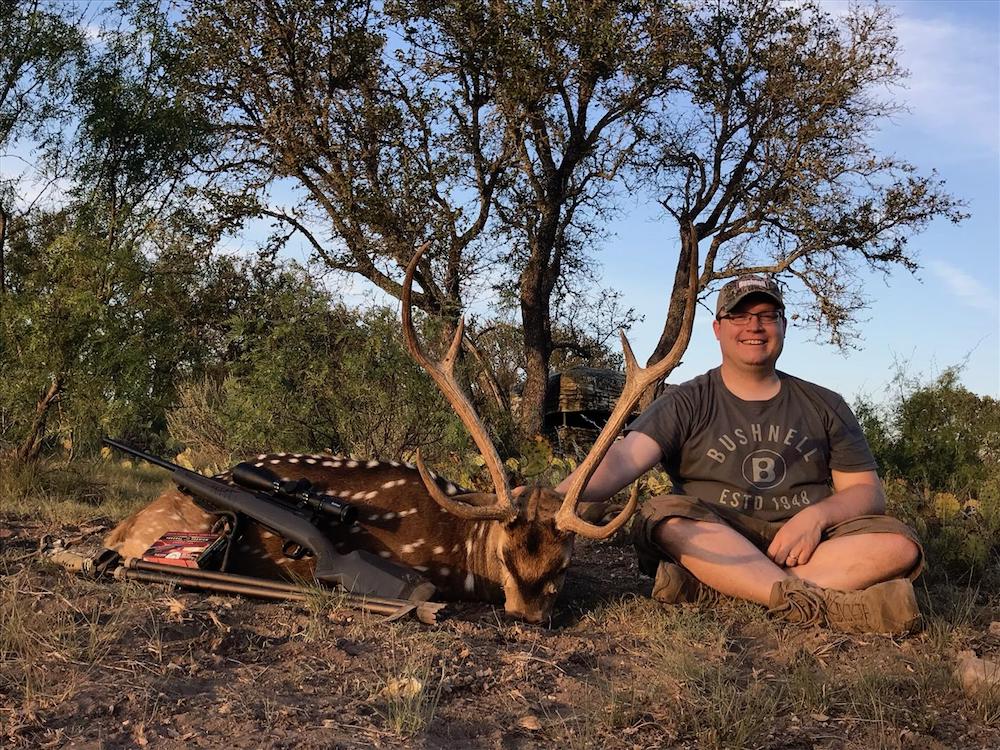Traveling whitetail hunters from coast to coast all dream of pursuing monster bucks in famous places like Kansas, Illinois, Iowa and more. Me, too. I’ve done it dozens of times, sometimes on my own on public land, often on a guided hunt on private property. It’s always exciting, knowing that any minute a giant could come trolling past your stand.
The past few years I’ve also gotten into a new type of hunting — exotics in Texas. Of them, by far my favorite is hunting Axis deer. Introduced to Texas from India in 1932 as a game animal on fenced-hunting sites, the animals were brought in for food purposes. Since their introduction, axis deer have escaped captivity and are now established in Texas on both low- and high-fence ranches.
The game department guesstimates that today there are between 6,000-8,000 free-ranging axis deer and 40,000 or more kept on high-fenced, private-hunting ranches in the Lonestar State. High-fence hunting does nothing for me, but hunting free-range axis deer on a good ranch is a blast.
Most active at dawn and dusk, mature males are about the size of the average whitetail buck, weighing between 150-250 pounds on the hoof, with females rarely exceeding 150 pounds. For any hunter on a budget that limits them to maybe one quality, guided hunt each year, here’s why I would seriously consider an axis hunt over Midwestern whitetails.

Dan Summers, president of QAD, took this dandy buck with his bow in June 2018. Axis deer are a great bowhunting animal. Photo: Bob Robb
1) The Axis Herd
Axis deer herds are comprised of males and females of various ages throughout the year.
Bonus: Axis deer rut all year around, so it is not unusual to see animals in the same group ranging from young fawns to hard-antlered mature males, males with antlers in velvet and males with antlers in all stages of maturation.
2) They’re Wary
Like whitetails, axis deer have excellent senses of smell and hearing, with good eyes as well. Getting a good shot takes stealth and preparation. Make one false move and they’re outta here. They’re also tough, so precise shot placement is critical.
3) Use What You Want
Unlike whitetail hunting where a hunter must obtain a tag for a specific weapon, this isn't the case with Texas exotics like axis deer. You can use pretty much anything you want. I’ve shot them with rifles, compound bows and crossbows -- and every hunt was a blast.
4) Hunt Style
Let’s face it, whitetail hunting is all about taking a stand and waiting ‘em out. With axis deer hunting, stands are also the most common way to hunt. Everything from ground blinds to commercial shooting houses to tree stands are employed, depending. But you can also spot and stalk them, which is both great fun and a real challenge. I’ve done it both from blinds and sneaking about.
5) Pure Protein
Axis deer meat contains less than one percent fat. It's a beautiful, deep red and is — without question — the tastiest game meat I have ever eaten. And I do love my whitetail meat. You can buy it in select meat stores, and on the open market, ground axis meat can sell for upwards of $20/pound.
6) The Time Factor
Most guided whitetail hunts in the Midwest give you five hunting days. Most outfitted private ranch axis deer hunts generally last only three days, which eats up less than a week of your time when you factor in a day of travel to Texas on each end. Which leads me to …
7) High Success Rates
The reason axis hunts are usually only three days is because it’s the rare axis-deer hunter who does not get a quality shot at a mature buck during this time. In fact on many — though certainly not all — ranches you are allowed to take one axis buck, one axis doe and as many wild hogs as you can shoot during your hunt.
On a rifle hunt in June 2018, I killed a dandy buck, a fat doe and four little piggies. In our camp of 12 hunters (eight were bowhunters), everyone got a quality shot at a mature buck. Many other does and hogs were taken as well. Compare that to hunting Midwestern whitetails. The best guided hunts often have a one-in-three shot opportunity rate at a mature buck — or less — and no other animals can be harvested.

Jacob Edson took this dandy axis buck with his rifle on day two of a June 2018 hunt. He also shot several wild hogs and a fat axis doe for the freezer. Photo: Bob Robb
8) Tag Availability, Cost
Tired of playing the tag-draw game, where you may or may not draw a tag this year? With this process, you have to pay just to acquire a preference point so you might draw next year, or the year after that? In 2018, for example, nonresident hunters had only from April 1- 27 to apply for a Kansas deer permit, with a hunting license costing $97.50 ($42.50 for juniors age 15 and younger), and $443 for a deer permit ($118 if the hunter is 15 or younger).
You can hunt exotics in Texas with several different types of hunting licenses. All of which can be purchased over-the-counter. While you can use a Type 105 Nonresident General Hunting License that’s also valid for whitetail hunting and costs $315, all you need to hunt exotics is a Type 105 Nonresident 5-Day Special Hunting license, valid during any specified five-day period, which costs just $48.
9) The Perfect “Off-Season” Big-Game Hunt
Most whitetail firearms seasons only extend for a few days or weeks at most. And everybody wants to hunt during the magical rut period. That limits available spots with the best outfitters, and also drives up cost during the rut. With axis deer, rutting year around, you don’t have to worry about what month or week is best. And the season never closes. In fact, the bulk of axis deer hunting occurs during late spring and early summer, right after turkey seasons close and before it gets scalding hot.
10) Hunt Cost
A fully-outfitted, free-range, private-land Axis hunt costs somewhere between $2,000-$3,000, more or less. This is much less than most premium Midwestern whitetail deer hunts. Also on some ranches, if you want to harvest more animals, you can do that too, with prices varying. Hunts generally include comfortable ranch-style accommodations, more food than you should eat every day and field care of your animal and the meat. Other services like airport pickup, transporting meat to a processor and so on are available as well.
How do you find an outfitter?
A quick Google search of axis Deer Hunting in Texas will turn up dozens of guides and outfitters to call. A great place to begin looking for a hunt can be found at https://tpwd.texas.gov/huntwild/hunt/. One excellent outfitter I have hunted with several times — including this past June — is SOE Hunts. They’ve yet to disappoint me






